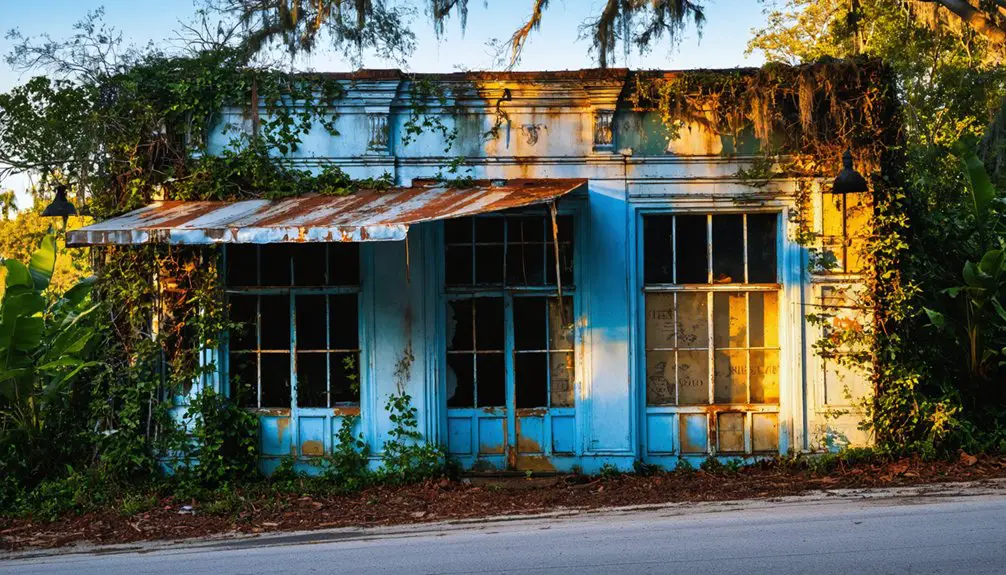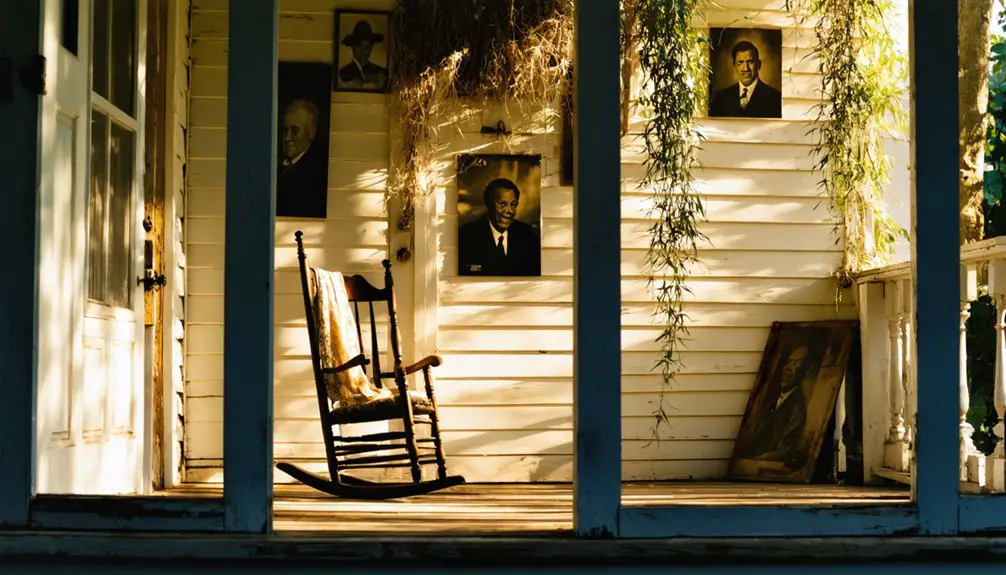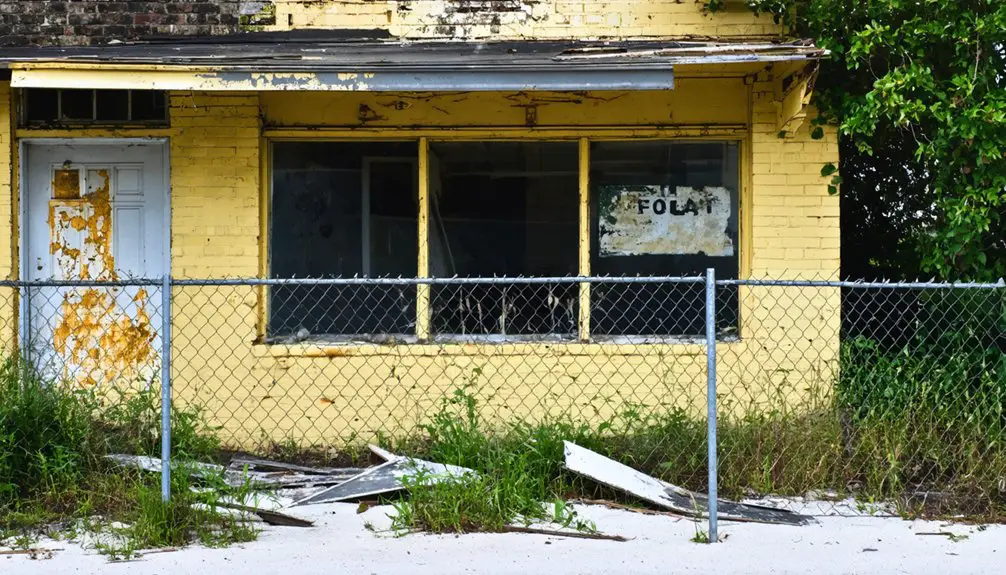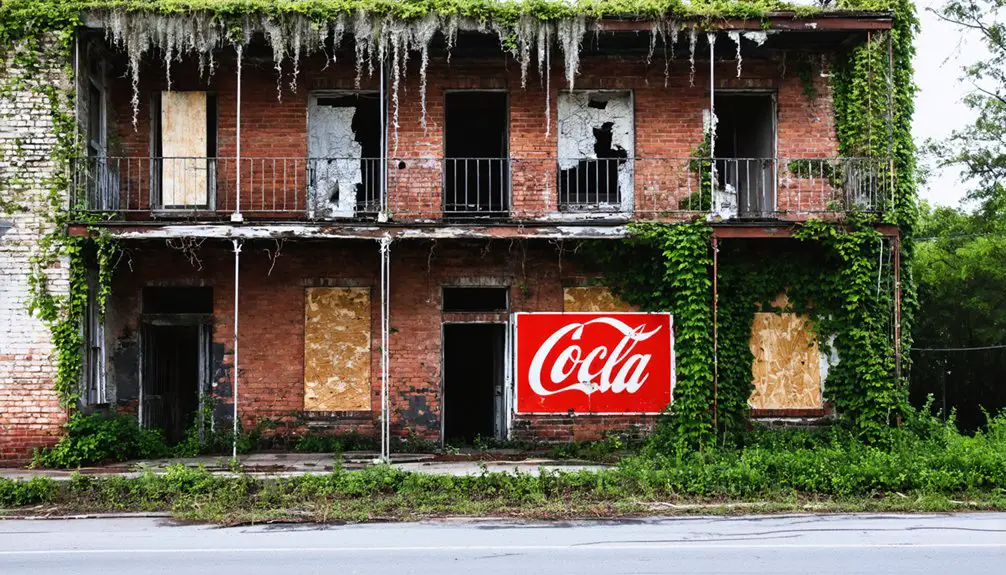You’ll find Parramore’s story in Orlando, where a vibrant African American community established in the 1880s faced devastating changes. Once anchored by the Wells’ Built Hotel and South Street Casino, the neighborhood thrived with Black-owned businesses until the 1957 construction of Interstate 4 demolished over 500 properties. While today’s 23.8% unemployment rate reflects decades of systemic challenges, Parramore’s historical landmarks and cultural heritage reveal an untold chapter of Florida’s past.
Key Takeaways
- Interstate 4 and State Road 408 construction displaced 1,000 homes and 200 businesses, devastating the community’s economic core.
- Once-thriving African American business district declined after infrastructure projects severed community networks and destroyed properties.
- Historic landmarks like Wells’ Built Hotel transformed from active businesses into museums, marking the area’s economic downturn.
- Waterfront commerce collapse and industrial zoning restrictions in 1928 eliminated crucial economic opportunities for local businesses.
- The 23.8% unemployment rate reflects the area’s transformation from a bustling community into an economically challenged neighborhood.
The Rise and Fall of a River Town

While Parramore wasn’t actually a river town, this African-American neighborhood emerged in Orlando during the 1880s under the direction of Mayor James B. Parramore.
You’ll find that despite being established as a segregated community to house Black workers serving white households, residents demonstrated remarkable community resilience by building a thriving district from the ground up. Dr. William Monroe Wells delivered nearly 6,000 babies as the only Black doctor in Orlando during WWII. Today the area faces significant economic challenges with a 23.8% unemployment rate affecting local development and growth.
Life Along the Chattahoochee
You’d find Parramore’s riverfront bustling in the 1850s, as steamboats laden with cotton, timber, and agricultural goods made regular stops along the Chattahoochee’s banks.
Your daily activities would’ve centered around the rhythms of river commerce, from loading cargo at dawn to welcoming passenger boats at dusk.
If you’d lived in Parramore during this era, you’d have witnessed a constant flow of traders, travelers, and river workers who transformed this settlement into a crucial link between inland plantations and coastal markets.
Evidence of this area’s importance dates back millennia, with ancient earthen mounds discovered at the river’s headwaters that are nearly 2,000 years old.
The Chattahoochee served as a vital pathway connecting these communities, with Spanish explorers first attempting to establish trade with the Creeks in 1639.
Riverboat Commerce Era
Three distinct phases marked Parramore’s riverboat culture era, with the post-Civil War period emerging as its most prosperous.
You’d have witnessed a dramatic economic transformation as paddlewheel steamers navigated the Chattahoochee, connecting the town to larger markets downstream.
- Cotton and timber shipments drove the port’s bustling commerce
- Skilled river pilots mastered the challenging Chattahoochee waters
- Sawmills and cotton gins flourished along the riverbank
- Merchants and travelers brought cultural diversity to the town
- Seasonal river conditions dictated trade patterns and social life
The riverfront became your community’s beating heart, where loading docks buzzed with activity and locals gathered to trade. The George Macy Mill operated alongside the water, processing grain and cotton for the growing community. The area’s development mirrored other segregated Black settlements that emerged after the Homestead Act of 1866.
Parramore’s strategic location made it a crucial regional hub, though this golden age would eventually yield to the rising dominance of rail transport.
Daily Settlement Activities
Despite limited amenities during its early settlement, Parramore’s daily life centered around a vibrant network of essential services that emerged between 1890 and 1920.
Dr. William Monroe Wells enhanced community life by establishing the Wells’ Built Hotel, which became a cultural cornerstone for African American residents.
You’d find residents conducting their daily routines at the local post office, cotton gin, sawmill, and blacksmith shop.
Community gatherings often took place at churches, which served as both spiritual sanctuaries and social hubs.
The town’s economy thrived through riverboat commerce along the Chattahoochee River.
Historical Landmarks and Structures
While Parramore’s landscape has changed dramatically over the decades, several historic landmarks stand as proof of the African American community’s resilience and cultural heritage.
These structures reflect the determination of local leaders who established spaces for education, entertainment, and professional advancement during segregation. Tinker Field‘s historic plaza honors baseball legends and civil rights leaders who shaped the community. The Oak Grove Church once served as the central gathering place where the community flourished during its peak years.
- The Wells’Built Hotel, now a museum, welcomed legendary performers like Ella Fitzgerald and Ray Charles when they couldn’t stay elsewhere.
- Mt. Zion and Ebenezer churches hold historic landmark status, protecting their legacy of community faith.
- The Art Moderne Hankins Building served as the first Black-owned professional center and NAACP headquarters.
- Mount Pleasant Baptist Church stands as Orlando’s first masonry African American church.
- Early farm structures and ruins, like the Old School House and Sugar Furnace, tell stories of agricultural roots.
Transportation and Commerce Legacy
As you explore Parramore’s early commerce, you’ll discover its crucial role as a riverboat trading post along the Chattahoochee River from 1890-1920, where cotton processing and agricultural trade flourished.
The arrival of the railroad in the late 19th century initially boosted commerce but ultimately served as a physical barrier that segregated the African American community from Orlando’s economic opportunities.
While the waterfront commerce gradually declined, the construction of Interstate 4 in 1957 and State Road 408 in 1974 delivered the final blow to Parramore’s trading legacy, destroying hundreds of local businesses and severing remaining commercial connections.
Riverboat Trade Hub
During the golden age of riverboat commerce between 1890 and 1920, Parramore established itself as an essential trade hub connecting Florida’s agricultural heartland to Gulf Coast markets.
You’ll find that riverboat routes stretched westward to key ports like Cedar Key, Pensacola, and Mobile, fostering crucial economic partnerships between local producers and boat operators.
- Citrus and fisheries products moved efficiently from rural areas to urban markets
- Trade collaborations like McMullen and Axelson’s strengthened regional commerce
- Waterborne transport provided alternatives to limited overland routes
- Investment in riverfront infrastructure created local jobs
- Perishable goods reached distant markets before spoiling
This vibrant riverboat economy helped transform Parramore from a subsistence farming community into a significant commercial center, setting the foundation for Orlando’s future growth.
Railroad Impact Analysis
The railroad’s arrival in Orlando during the 1880s marked a significant shift from riverboat commerce, but brought complex social and economic consequences for the Parramore community.
You’ll find that while the tracks initially provided essential employment opportunities for African American residents in rail yards and related businesses, they simultaneously served as a tool of racial segregation, enforcing stark boundaries between Parramore and white Orlando neighborhoods.
This railroad isolation intensified when Interstate 4’s construction in 1957 demolished over 500 properties, severing established community networks.
The combination of the railroad tracks and I-4 created lasting economic disparities, transforming what was once a thriving African American business district into an increasingly marginalized neighborhood.
The infrastructure that once supported Parramore’s growth ultimately contributed to its decline.
Waterway Commerce Decline
Once integral to Parramore’s economic importance, waterway commerce supported a thriving network of Black-owned businesses and marketplaces in early 20th-century Orlando.
You’ll find that waterway revitalization efforts couldn’t prevent the decline that began when alternative transportation modes emerged, dramatically reducing economic opportunities for local African American entrepreneurs.
- By 1928, industrial zoning decisions severely limited commercial development near waterways.
- The WellsBuilt Hotel and South Street Casino’s economic foundation weakened as water trade diminished.
- Around 1,000 homes and 200 businesses were displaced by highway construction in the 1960s.
- Local markets and gathering places near docks gradually disappeared.
- Waterfront commerce gave way to lower-wage industrial jobs.
This shift from water-based trade to highways and railroads fragmented Parramore’s commercial districts, accelerating the neighborhood’s economic decline and community displacement.
Religious Heritage and Sacred Spaces
While many historic neighborhoods have lost their religious landmarks to time and development, Parramore’s spiritual heritage remains visible through its 1920s-era churches that served as pillars of Orlando’s African American community.
These sacred spaces emerged during segregation through remarkable community resilience, with congregations like Mount Pleasant Missionary Baptist Church hand-crafting concrete blocks for their own buildings.
You’ll find the Spanish Mission-style Pleasant Hill Community Colored Methodist Episcopal Church, established in 1916, standing as a symbol of faith and determination.
Though Hurricane Ian severely damaged the Black Bottom House of Prayer in 2022, preservation efforts, including a $500,000 grant, aim to restore these cultural touchstones.
Despite urban renewal and Interstate 4’s disruption, these churches continue anchoring Parramore’s religious identity.
Notable Residents and Their Stories

Dating back to its 1870s riverboat landing origins, Parramore’s social fabric was woven by pioneering families like the Clouds, Lawsons, and Coxes, who established the area’s early farms and businesses.
Among the notable figures who shaped this vibrant community was Woodford James Maxey, one of Orlando’s first African American letter carriers, and his wife Mamie Crooms.
Woodford Maxey broke barriers as one of Orlando’s pioneering Black postal workers, serving the Parramore community alongside his wife Mamie.
- William Monroe Wells owned the South Street Casino, providing a safe haven for Black performers.
- The Lawson family hosted major community dances, fostering local cultural traditions.
- Community leaders fought against Jim Crow restrictions to maintain social cohesion.
- Pioneer families operated essential services including the post office and grist mill.
- Black business owners like Wells created spaces where legendary musicians like Ray Charles could safely perform and lodge.
Archaeological Findings and Preservation
Recent archaeological surveys across Northwest Florida have revealed a rich tapestry of history beneath Parramore’s transformed landscape. You’ll find evidence of prehistoric cultures through pottery fragments and stone tools dating back to the Archaic period, alongside remnants of 19th-century industrial sites like Muskogee Mills.
The battle for archaeological preservation faces significant challenges. You’re witnessing the impact of urban renewal projects, particularly Interstate 4 and State Road 408’s construction, which destroyed over a thousand homes and fragmented historical sites.
The cultural heritage of historically African American neighborhoods continues to vanish under municipal development and neglect by absentee landlords. Without community involvement and transparent planning, these irreplaceable artifacts and structures remain at risk.
Recent excavations have uncovered indigenous settlements near waterways and early American logging infrastructure, documenting the area’s evolution from native lands to commercial development.
Exploring the Ghost Town Today

Although much of the original Parramore ghost town near the Chattahoochee River stands abandoned, you’ll find a complex landscape of historical significance throughout the broader Parramore district.
While urban exploration of deteriorating structures isn’t safe due to structural instability, you can experience this rich cultural heritage through guided tours and preserved landmarks.
- Join the Parramore Historic Bus Tour to learn about African American entrepreneurs and civil rights history
- Visit the Art Moderne-styled Hankins Building, former home of Orlando’s NAACP chapter
- Explore the Wells’Built Hotel and South Street Casino, essential community hubs from the mid-1900s
- Discover Tinker Field, protected from redevelopment to preserve its historical integrity
- Experience guided viewings of original early 1900s houses that tell stories of community resilience
Photographic Journey Through Time
Through preserved photographs spanning over 150 years, you can trace Parramore’s transformation from a bustling riverboat landing to its current state as a ghost town.
Early photographic preservation shows thriving riverboat landings, the Oak Grove Church, and farms bustling with cotton and sugarcane production. You’ll find images of community storytelling through captured moments of dances at Lawson Farm and gatherings at the one-room schoolhouse.
Preserved snapshots reveal vibrant gatherings at Lawson Farm dances and cherished moments at Oak Grove Church, capturing Parramore’s spirited community life.
By the mid-20th century, you’ll notice a stark shift as Interstate 4’s construction tears through the heart of Parramore, displacing hundreds of properties.
The most recent photographs reveal the remnants of this once-vibrant community – the Old School House ruins, abandoned turpentine still, and the historic graveyard stand as silent witnesses to Parramore’s dramatic journey through time.
Frequently Asked Questions
Are There Any Dangerous Wildlife Encounters Reported in Parramore’s Ruins?
You’ll be relieved to know there aren’t any documented dangerous wildlife sightings in Parramore’s ruins, though it’s wise to take standard safety precautions as you would in any urban Florida setting.
What Happened to the Original Town Records and Documents?
You’ll find most original records were lost during urban renewal projects, with missing archives scattered or destroyed when I-4 and 408 demolished homes. Historical preservation wasn’t prioritized during Parramore’s forced transformation.
Does Anyone Still Own Property Rights in the Ghost Town?
As you’d explore the overgrown ruins today, you’ll find private property ownership still exists through descendants and buyers, though many legal claims remain dormant with minimal development or active use.
Are There Any Local Legends or Ghost Stories About Parramore?
You’ll find stories of haunted history at the old Lawson Farm’s dance floor and Oak Grove Church cemetery, where locals report paranormal sightings of former residents and riverboat travelers.
When Was the Last Permanent Resident Recorded Living in Parramore?
Like many frontier settlements that faded into myth, you won’t find clear records of Parramore’s final resident. Historical timelines suggest the last permanent inhabitants left before the 1970s, when stores were demolished.
References
- https://anthroyeti.net/2020/06/23/parramore-minidoc/
- https://www.exploresouthernhistory.com/parramore.html
- https://sites.rootsweb.com/~fljackso/ParamoreComm.html
- https://www.goodreads.com/book/show/13280062-old-parramore
- https://www.youtube.com/watch?v=UDWh_Mb09BU
- https://en.wikipedia.org/wiki/Parramore
- https://scholarship.rollins.edu/cgi/viewcontent.cgi?article=1074&context=mls
- https://parramoremainstreet.com/the-historic-parramore-district/
- https://twoegg.blogspot.com/2014/04/
- https://garivers.org/chattahoochee-river/



